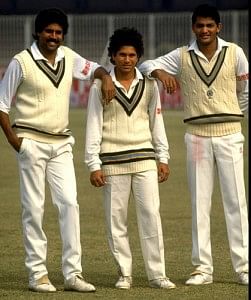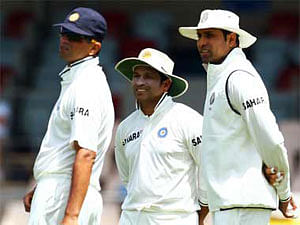
The quest to glory - two decades of Indian cricket!
Cricket has always been the gentleman’s game; the game of the colonials. But when it comes down to the subcontinent, to a nation named India, it can no longer be called just a game. People worship the sport; they love, breathe and live the so-called colonial fantasy. It is not just a game here, it’s much more. It’s a religion and perhaps the biggest uniting force in this nation already filled with numerous kinds and types of discrimination. From Kashmir to Kerala, the spirit for cricket is something that can never be dented, because this game lives in the heart of every common man of this huge nation.

India’s first ever Test victory came against England at Madras in 1952. India’s first series victory was against Pakistan later the same year. Indian cricket in the 1990s had come a long way from here. India’s batting strengths had shifted from Polly Umrigar and Vijay Manjrekar to Sunil Gavaskar and Sachin Tendulkar. With the glory of the 1983 World Cup victory bestowing its pride over the team, India had come a long way from being an underdog to being a powerful team in the world. Mohammad Azharuddin had been India’s captain from the early 1990′s to a major part of the decade. It was under his leadership that many youngsters of that time and legends of our time made their mark – namely Rahul Dravid, Sourav Ganguly, VVS Laxman, Anil Kumble and the one and only Sachin Tendulkar. At the beginning of the 1990s, India didn’t possess a formidable batting line up or threatening bowling fire power; the team was mostly centered around a few players. Though the team had capable and crafty batsmen in Mohammad Azharuddin, Ajay Jadeja, Sachin Tendulkar , SS Das, Nayan Mongia, the times when they rose to their potential was too rare. The burden of taking the team forward was mainly dumped on the shoulders of Azhar, with a lending hand from Tendulkar at times. It’s also true that it took Tendulkar over four years to get on track in the one day format of the game and this period in Indian cricket was not a fairy tale - it was full of hardships and setbacks. The team lost on many tours, India’s vulnerability in foreign conditions was being exposed which, to a certain extent, still remains. Mohammed Azharuddin, who captained India for most of the 1990s, proved a captain whose main strength – if not his motivational skills – was his ability to stay cool under pressure. Azharuddin’s artistic batting however, declined during the later years of his captaincy, and his best innings during this time were mostly when playing at home.
The so-called golden era of Indian cricket began in the mid 1990s with the emergence of the Fab 4. A lineup of Sachin, Dravid, Ganguly and Laxman with the spin-wizard Anil Kumble was indeed a fearful prospect. The late 1990s marked another disaster in Indian cricket: the match-fixing scandal took the cricketing world by storm and with the accused ranging from Mohammad Azharuddin to Ajay Jadeja, the team’s reputation and self-esteem was being reduced. The country of cricket frenzy fans could not take this matter lightly; in India the game is not just a pass time, it’s more of a way of living. And in such a place, it was not a big shock when such an issue was made huge. The fans turned violent and the accused were mostly portrayed as traitors. The BCCI also took a strong stand on the matter and handed a lifetime ban on Mohammad Azharuddin.
After the dethroning of Azhar, Tendulkar took over the captaincy. He had a short stint as India’s skipper. He decided to give up captaincy at the beginning of 2000 and that led to the rise of a new era in Indian cricket under Dada – Sourav Ganguly – the man who hailed from the state of warriors and had a never-say-die attitude. He had the heart to bring up a struggling team to new heights. Ganguly never had a team of stars to carry around. Apart from Sachin, Dravid and Kumble, there were no senior or permanent members in the squad. Ganguly was indeed a courageous captain. With John Wright taking over the coach’s position in 2000, a new Indian team was born. The team had the courage to be daring, to stand toe-to-toe with any opponent and fight till the very end. Under Ganguly’s captaincy, the Indian team went a long way. Many players namely, Virender Sehwag, Harbhajan Singh, Yuvraj Singh, all became a permanent part of the Indian squad. The most interesting part about Virender Sehwag was that before Ganguly had made him to open the innings for India in an international match, he had never been an opener – not even for his state side. To take such a daring decision at such a stage, it required some mettle and Ganguly had it. He has always been the man with the difference; a person who thought differently and did things differently. His effect on the team was mainly portrayed in India’s 2003 World Cup performance where India ended as runner ups.

The team had a great captain in Ganguly, maybe the best India ever had. The Indian team never had a better overseas record under any captain. The game had changed, the goal was being set and the target was complete dominance. Ganguly had brought a team from 10th position to the 3rd position in the ICC ranking and that does deserve some credit. After the 2003 World Cup, the team had quite a good streak of form, doing well overseas and in India against all opponents. They even beat the formidable Aussies in India. The team was indeed growing. Then was an era of transformation in the team. Names like Dravid, Laxman and Kumble started to vanish from the One Day set up, as the board and the selectors went back to the policy of “horses for courses”, and new names like Dhoni, Raina, Gambhir, Pathan came about. The transition was gradual, mainly under Greg Chappell. Chappell always encouraged change, but not the way Indians wanted it. The spat between Ganguly and him led to Ganguly losing his position in the squad. It can just plainly be termed as a conflict of interest, but a player like Ganguly did deserve a better approach from the board.
The post-Ganguly age in Indian cricket has been an electrifying one. The team scaled to new heights under its new found captain cool MSD. The team, studded with stars in all aspects, rose to the podium when the occasion demanded and set new milestones. They did come up with much-desired results. The team now has perhaps the most balanced side in the last two decades and we have the 2011 World Cup trophy. The much-debated topic now is whether we had a better captain in Sourav Ganguly or we have a better one in MS Dhoni. Dhoni took the team to the No.1 position in Tests from the 3rd or 4th position. Ganguly took the team to the third position from dire straits. You choose the answer.